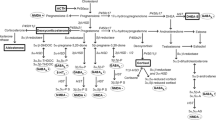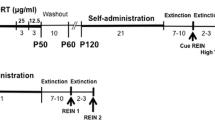Abstract
The daily fluid intake of male Wistar rats with simultaneous access to 6% ethanol and water was determined during a baseline period (1 week), following adrenalectomy (1 week) and for 3 weeks following SC implantation of hormone pellets containing corticosterone (CORT) or dexamethasone (DEX). Ethanol consumption dropped during the first week of adrenalectomy (ADX) but increased again in the absence of hormone replacement to reach preoperative levels during the ensuing weeks. The CORT treatment, which produced plasma hormone levels similar to the 24-h mean concentration of adrenally intact rats, not only reversed the effect of ADX on alcohol consumption but also enhanced it to levels above those observed in intact rats. Water intake was not affected by the CORT treatment. DEX implants stimulated water intake, but did not enhance the drinking of ethanol. SC injections of RU 28318 (type I corticosterone receptor antagonist; 10 mg/kg) or mifepristone (RU 38486; type II receptor antagonist; 25 mg/kg) at the beginning and halfway through three daily, 6-h tests failed to affect ethanol drinking in adrenally intact rats or in ADX rats bearing CORT implants. Similarly, there was no effect of giving the two antagonists in combination. These results suggest that exogenous CORT can induce excessive alcohol intake in genetically unselected rats and that this facilitatory effect may be mediated by non-genomic cellular mechanisms.
Similar content being viewed by others
References
Ahima R, Harlan (1990) Charting of type II glucoreceptor-like immunoreactivity in the rat central nervous system. Neuroscience 39:579–604
Ahima R, Krozowski Z, Harlan, R (1991) Type I corticosteroid receptor-like immunoreactivity in the rat CNS: distribution and regulation by corticosteroids. J. Comp Neurol 313:522–538
Almeida OFX, Hassan AHS, Harbuz MS, Linton EA, Lightman SL (1992) Hypothalamic corticotropin-releasing hormone and opioid peptide neurons: functional changes after adrenalectomy and/or castration. Brain Res 571:189–198
Barnett SA (1963) A study in behaviour. Camelot Press, London, p 203
Bhakthavatsalam P, Leibowitz SF (1986) Morphine-elicited feeding: diurnal rhythm, circulating corticosterone and macronutrient selection. Pharmacol Biochem Behav 24:911–917
Bice PJ, Keefer SW, Elder NB (1992) Evaluating the palatibility of alcohol for rats with measures of taste reactivity, consumption, and lick rate. Alcohol 9:381–387
Bohus B, Koolhaas JM, Korte SM, Bouws GAH, Eisenga W, Smit J (1990) Behavioural physiology of serotonergic and steroid-like anxiolytics as antistress drugs. Neurosci Biobehav Rev 14:529–534
Burnet PWJ, Mefford IN, Smith CC, Gold PW, Sternberg EM (1992) Hippocampal 8-3H-hydroxy-2-(di-n-propylamino) tetralin binding site densities, serotonin receptor 5-HT1A messenger ribonucleic acid abundance, and serotonin levels parallel the activity of the hypothalamo-pituitary-adrenal axis in rat. J Neurochem 59:1062–1070
Chalmers DT, Kwak SP, Mansour A, Akil H. Watson SJ (1993) Corticosteroids regulate brain hippocampal 5-HT1A receptor mRNA expression. J Neurosci 13:914–923
Chao HM, McEwen BS (1990) Glucocorticoid regulation of proenkephalin messenger ribonucleic acid in the rat striatum. Endocrinology 126:3124–3130
Christian JJ (1955) Effect of population size on the adrenal glands and reproductive organs of male mice in populations of fixed size. Am J Physiol 182:292–300
Dallman MF, Akana SF, Scribner KA, Bradbury MJ, Walker C-D, Strack AM, Cascio CS (1992) Stress, feedback and facilitation in the hypothalamo-pituitary-adrenal axis. J Neuroendocrinol 4:517–526
Deroche V, Piazza PV, Deminière, Le Moal M, Simon H (1993) Rats orally self-administer corticosterone. Brain Res 622:315–320
Engel JA, Enerbäck C, Fahlke C, Hulthe P, Hård E, Johannessen K, Svensson L, Söderpalm B (1992) Serotonergic and dopaminergic involvement in ethanol intake. In: CA Naranjo, EM Sellers (eds) Novel pharmacological interventions for alcoholism. Springer, Berlin, pp 68–82
Esposito RU, Parker ES, Weingartner H (1984) Enkephalinergicdopaminergic “reward” pathways: a critical substrate for the stimulatory, euphoric and memory-enhancing actions of alcohol-a hypothesis. Subs Alcohol Act/Misuse 5:111–119
Fahlke C, Engel JA, Eriksson CP, Hård E, Söderpalm B (1994a) Involvement of corticosterone in the modulation of ethanol consumption in the rat. Alcohol 11:195–202
Fahlke C, Hård E, Thomasson R, Engel JA, Hansen S (1994b) Metyrapone-induced suppression of corticosterone synthesis reduces ethanol consumption in high-preferring rats. Pharmacol Biochem Behav 48:977–981
Fahlke C, Thomasson R, Hård E, Engel JA, Hansen S (1994c) Taste reactivity to alcohol in rats: influence of adrenalectomy or ipsapirone. Alcohol 11:289–294
Froehlich JC, Harts J, Lumeng L, Li T-K (1990) Naloxone attenuates voluntary ethanol intake in rats selectively bred for high ethanol preference. Pharmacol Biochem Behav 385:390
Ganong WF (1987) Review of medical physiology. Appleton & Lange, Norwalk
Guhl AM (1961) Gonadal hormones and social behavior in infrahuman vertebrates. In: Young WC (ed) Sex and internal secretions, vol 2. Williams & Wilkins, Baltimore, pp 1240–1267
Gustafsson J-Å, Carlstedt-Duke J, Poellinger L, Okret S, Wikström A-C, Brönnegård M, Gilner M, Dong Y, Fuxe K, Cintra A, Härfstrand A, Agnati L (1987) Biochemistry, molecular biology, and physiology of the glucocorticoid receptor. Endocrine Rev 8:185–234
Haleem DJ (1992) Repeated corticosterone treatment attenuates behavioural and neuroendocrine responses to 8-hydroxy-2-(di-n-propylamino) tetralin in rats. Life Sci 51:PL225-PL230
Hansen S, Södersten P, Srebro B (1978) A daily rhythm in the behavioural sensitivity of the female rat to oestradiol. J. Endocrinol 77:381–388
Hansen S, Fahlke C, Hård E, Engel JA (1994) Adrenal corticosteroids modulate the consumption of ethanol in the rat. In: T Palomo, T Archer (eds) Strategies for studying brain disorders: depressive anxiety and abuse disorders. Farand Press, London vol. 3, pp 465–479
Härfstrand A, Fuxe K, Cintra A, Agnati LF, Zini I, Wikström A-C, Okret S, Yu Z-Y, Goldstein M, Steinbusch H, Verhofstad A, Gustafsson J-Å (1986) Glucocorticoid receptor immunoreactivity in monoaminergic neurons of rat brain. Proc Natl Acad Sci USA 83:9779–9783
Herbert J, Klinowska M (1978) Day length and the annual reproductive cycle in the ferret (Mustela furo): the role of the pineal body. In: I Assenmacher, DS Farner (eds) Environmental endocrinology. Springer, Berlin, pp 87–93
Jacobson L, Sapolsky R (1991) The role of the hippocampus in feedback regulation of the hypothalamic-pituitary-adrenocortical axis. Endocrine Rev 12:118–134
Joëls M, de Kloet ER (1992) Control of neuronal excitability by corticosteroid hormones. Trends Neurosci 15:25–30
Kalimi M (1989) Role of antiglucocorticoid RU486 on dexamethasone-induced hypertension in rats. Am J Physiol 256:E682-E685
Langley SC, York DA (1990) Effects of antiglucocorticoid RU 486 on development of obesity in obese fa/fa Zucker rats. Am J Physiol 259:R539-R544
Leibowitz SF (1992) Neurochemical-neuroendocrine systems in the brain controlling macronutrient intake and metabolism. Trend Neurosci 15:491–496
MacLennan AJ, Drugan RC, Hyson RL, Maier SF, Madden JD, Barchas JD (1982) Corticosterone: a critical factor in an opioid form of stress-induced analgesia. Science 215:1530–1532
Mendelson SD, McEwen BS (1992) Autoradiographic analyses of the effects of adrenalectomy and corticosterone on 5-HT1A and 5-HT1B receptors in the dorsal hippocampus and cortex of the rat. Neuroendocrinology 55:444–450
McEwen BS (1991) Non-genomic and genomic effects of steroids on neural activity. Trends Pharmacol Sci 12:141–147
McEwen BS, De Kloet ER, Rostene W (1986) Adrenal steroid receptors and actions in the nervous system. Physiol Rev 66:1121–1188
Moguilewsky M, Raynaud JR (1980) Evidence for a specific mineralocorticoid receptor in rat pituitary and brain. J Steroid Biochem 12:309–314
Moore FL, Orichinik M (1991) Multiple molecular actions for steroids in the regulation of reproductive behaviors. Semin Neuro-sci 3:489–496
Morin LP, Forger NG (1982) Endocrine control of ethanol intake by rats or hamsters: relative contributions of the ovaries, adrenals and steroids. Pharmacol Biochem Behav 17:529–537
Nemeroff CB, Krishnan KKR, Reed D, Leder R, Beam C, Dunnick NR (1992) Adrenal gland enlargement in major depression: a computed tomography study. Arch Gen Psychiatry 49:384–387
Oitzl MS, De Kloet ER (1992) Selective corticosteroid antagonists modulate specific aspects of spatial orientation learning. Behav Neurosci 106:62–71
Philibert D, Moguilewski M, Mary I, Lecaque D, Tornemine C, Secchi C, Deraedt R (1985) Pharmacological profile of RU486 in animals. In: Baulieu EE, Segal SH (eds) The antiprogestin steroid RU486 and human fertility control. Plenum, New York, pp 49–68
Piazza PV, Deminière JM, Le Moal M, Simon H (1990) Stress- and pharmacologically-induced behavioral sensitization increases vulnerability to acquisition of amphetamine self-administration. Brain Res 514:22–26
Piazza PV, Deminière JM, Maccari S, Le Moal M, Mormède P, Simon H (1991a) Individual vulnerability to drug self-administration: action of corticosterone on dopaminergic systems as a possible pathophysiological mechanism. In: Willner P, Scheel-Krüger J (eds) The mesolimbic dopamine system: from motivation to action. Wiley, Chichester, pp 473–495
Piazza PV, Maccari S, Deminière J-M, Le Moal M, Mormède P, Simon H (1991b) Corticosterone levels determine individual vulnerability to amphetamine self-administration. Proc Natl Acad Sci USA 88:2088–2092
Piazza PV, Deroche V, Roughé-Pont F, Deminière JM, Maccari S, Le Moal M, Simon H (1992) Individual differences in the sensitivity to corticosterone's reinforcing effects and in corticosterone-induced dopamine release may be a biological basis for sensation-seeking. Soc Neurosci Abstr 449:13
Pulvirenti L, Kastin AJ (1988) Naloxone, but not Tyr-MIF-1, reduces volitional ethanol drinking in rats: correlation with degree of spontaneous preference. Pharmacol Biochem Behav 31:129–134
Rachamin G, Luttge WG, Hunter BE, Walker DW (1989) Neither chronic exposure to ethanol nor aging affects type I or type II corticosteroid receptors in rat hippocampus. Exp Neurol 106:164–171
Ratka A, Veldhuis HD, De Kloet ER (1988) Corticosteroid effects on morphine-induced antinociception as a function of two types of corticosteroid receptors in brain. Neuropharmacology 27:15–21
Ratka A, Sutanto W, Bloemers M, de Kloet ER (1989) On the role of brain mineralocorticoid (type I) and glucocorticoid (type II) receptors in neuroendocrine regulation. Neuroendocrinology 50:117–123
Reid LD, Delconte JD, Nichols ML, Bilsky EJ, Hubbell CL (1991) Tests of opioid deficiency hypotheses of alcoholism. Alcohol 8:247–257
Reilly JJ, Mamani DB, Schulkin J, Slotnick B, McEwen BS, Sakai RR (1993) Adrenal steroid implants in the amygdala arouse sodium intake in the rat. Abstr Soc Neurosci 19:239.6
Sandi C, Borrell J, Guaza C (1988) Naloxone decreases ethanol consumption within a free choice paradigm in rats. Pharmacol Biochem Behav 29:39–43
Selye H (1936) Thymus and adrenals in the response of the organism to injuries and intoxication. Br J Pathol 17:234–248
Siegel S (1956) Nonparametric statistics for the behavioral sciences. McGraw-Hill, New York
Stewart J (1984) Reinstatement of heroin and cocaine self-administration behavior in the rat by intracerebral application of morphine in the ventral tegmental area. Pharmacol Biochem Behav 20:917–923
Sumners C, Gault TR, Fregly MJ (1991) Potentiation of angiotensin II-induced drinking by glucocorticoids is a specific glucocorticoid type II receptor (GR)-mediated event. Brain Res 552:283–290
Svensson L, Engel JA, Hård E (1989) Effects of the 5-HT receptor agonist, 8-OH-DPAT, on ethanol preference in the rat. Alcohol 6:17–21
Svensson L, Fahlke C, Hård E, Engel JA (1993) Involvement of the serotonergic system in ethanol intake in the rat. Alcohol 10:219–224
Tamarkin L, Westrom WK, Hamill AI, Goldman BD (1976) Effect of melatonin on the reproductive systems of male and female Syrian hamsters: a diurnal rhythm in the sensitivity to melatonin. Endocrinology 99:1534–1541
Author information
Authors and Affiliations
Rights and permissions
About this article
Cite this article
Fahlke, C., Hård, E., Hansen, S. et al. Consequence of long-term exposure to corticosterone or dexamethasone on ethanol consumption in the adrenalectomized rat, and the effect of type I and type II corticosteroid receptor antagonists. Psychopharmacology 117, 216–224 (1995). https://doi.org/10.1007/BF02245190
Received:
Revised:
Issue Date:
DOI: https://doi.org/10.1007/BF02245190




